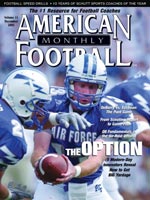AMERICAN FOOTBALL MONTHLY THE #1 RESOURCE FOR FOOTBALL COACHES
Article CategoriesAFM Magazine
|
Defensive Back Play in Quarters Coverageby: John Norton© More from this issue Stopping the run in football has always been paramount. Over the years coaches have devised different ways to get extra defenders into the box. Often times this has benefited the run game and it has also left the pass game vulnerable. I believe that quarters coverage provides an answer for both run and pass. It allows both of the safeties to be primary run support defenders while also allowing the defense to defend a vertical passing game.
Subscribe today!
|
|
||||||||
| HOME |
MAGAZINE |
SUBSCRIBE | ONLINE COLUMNISTS | COACHING VIDEOS |
Copyright 2025, AmericanFootballMonthly.com
All Rights Reserved






